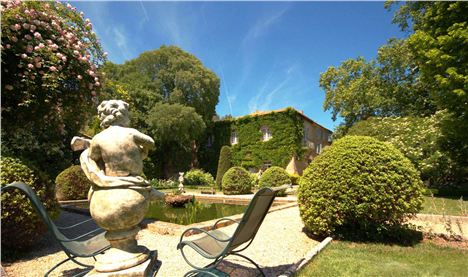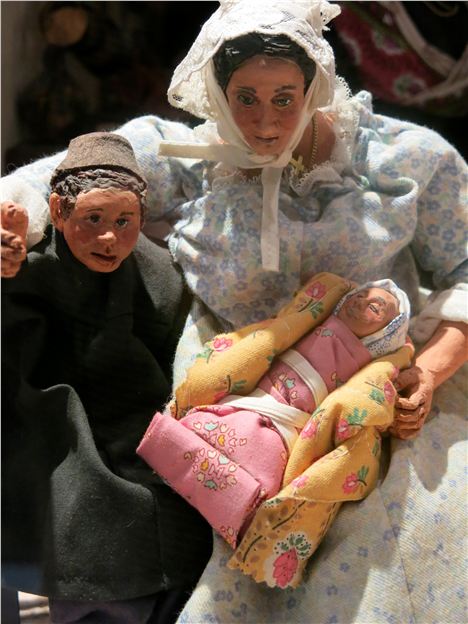 THERE was a time when Les Baux-de-Provence was not a welcoming place. Take Raymond Turenne, sadistic brigand of those parts. Once the great white castle on the crag had been Court of Love for the medieval Troubadours, but by the mid 14th century Raymond ruled, despatching his henchmen across the land to kidnap hapless wretches. If their families couldn’t pay the ransom he hurled his victims to their doom from a clifftop gangplank.
THERE was a time when Les Baux-de-Provence was not a welcoming place. Take Raymond Turenne, sadistic brigand of those parts. Once the great white castle on the crag had been Court of Love for the medieval Troubadours, but by the mid 14th century Raymond ruled, despatching his henchmen across the land to kidnap hapless wretches. If their families couldn’t pay the ransom he hurled his victims to their doom from a clifftop gangplank.
'Over strong cafe noir and pastries, we watched open-mouthed as fork lightning set a distant hillside ablaze'
Staring up at the rambling, ruined bastion that Cardinal Richelieu later called a "nesting place for eagles" (before ordering its destruction in 1652), it is easy to conjure up the ghosts of love and evil that haunt this stupendous spot. It helps as an aide memoire if you have a glass of terroir-rich organic local white in your hand and are lounging on the fragrant terrace outside your hotel room. Which I did.
 Our shared terrace at L'Oustau in the Provencal midday heat
Our shared terrace at L'Oustau in the Provencal midday heat
That hotel, L’Oustau de Baumaniere, is hewn from the same limestone as the walled town high above it and and stands at the entrance to the Le Val d’Enfer (the Valley of Hell) – so called because of the fantastical, twisted shapes of its rocky gorge. Impressionable guests have seen the caves of Dante’s Inferno in it and film-maker Jean Cocteau used it as the backdrop for his “Testament of Orpheus”. It’s a jaw-dropper.
 L'Oustau from above; below its fecund gardens
L'Oustau from above; below its fecund gardens
Anywhere less like Hell than L’Oustau, though, would be hard to imagine. The word legendary is over-used, particularly in the fickle world of hotelkeeping and fine dining, but this really was a game changer. Before World War II no places offering this degree of sophisticated hospitality existed away from major cities and trunk roads. An English equivalent would be the first “country house hotel”, Sharrow Bay in The Lakes but, with all due respects, L’Oustau is in a different league.
 Our bedroom in the original house; below, the hotel's dining room
Our bedroom in the original house; below, the hotel's dining room
The creator was another Raymond – the altogether more benevolent Raymond Thuilier. In 1945 he purchased a Provencal farmhouse (oustau), still today the core of the hotel. A certain Georges Pompidou, then Minister for Tourism, inaugurated the first rooms two years later. Cuisine was from the start a key ingredient – by 1954 L’Oustau held three Michelin stars. From the Queen Mother and Winston Churchill to Bono and Hugh Grant the celebs have always flocked here.
Raymond died aged 97 in 1993. Today L’Oustau is in the custody of his grandson, the affable Jean-Andre Charial, who has maintained the culinary standards despite the demotion to two stars. You are more likely to see him front of house these days than behind the stove. In 2005 he ceded the cheffing to Sylvestre Wahid, whose brother Jonathan is in charge of pastry.
The food shuns extreme modishness in pursuit of a classic approach rooted in the terroir. The restaurant is the main building – alongside seven rooms and four luxury suites all vastly different in style from each other – but the hotel extends into several properties now, equally attractive, including a separate Spa complex. The Grande Bastide, 900m down the valley, is particularly alluring. We were in the Oustau itself, in a compact but delicious suite, which combined upmarket 17th century rustic with state of the art luxury, particularly in the bathroom.
Our visit was too late in the year to for us to dip onto the Twenties-vintage outdoor pool or take dinner on the terrace. The tasting menu (and service) in the stone-vaulted dining room was exquisite.
One dish, in particular, stood out, red mullet on a tracery of green herb puree, while each cheese on the ample tray was, as they say, “au point”.
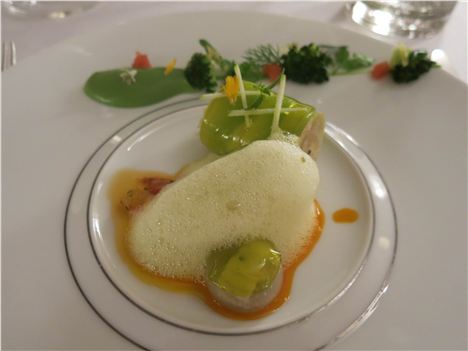 Exquisite fish starter was followed by red mullet and lamb courses
Exquisite fish starter was followed by red mullet and lamb courses
The meal was accompanied by the owner’s own wine, the biodynamic red L’Affectic from the Domaine de Lauzieres. Prunes and blackberries on the nose, black fruits and a hint of chocolate on the palate. The wine list proper is a roll call of France’s finest with a due nod to the appropriate Provence and Southern Rhone vineyards. On a tour of the cellars, Gilles Ozzelo, sommelier here for 30 years, showed me his oldest and most treasured bottle, a Chateau Lafite from 1870.
 Gilles Ozzello, sommelier at Baumaniere for over 30 years
Gilles Ozzello, sommelier at Baumaniere for over 30 years
This level of pampering is at odds with touristique Les Baux proper, up the hill. Get there early to avoid the crowds, they advise. Well, the coach drivers must set their alarms well before dawn. Officially one of “The Most Beautiful Villages in France”, it is among its most popular tourist spots with parking at a premium.
Yes, there are tat merchants on the main drag up to the Castle, but not all the food franchises are dreadful as you might imagine and there are quiet crannies. After a walk on a near-deserted, circular path clinging to the outside of the bastion, all buzzing insects and scents of garrigue herbs, we holed up at the Relais de la Porte D’Eyguieres for a welcome glass of Duvel beer.
 12th century Eglise St Vincent – a quiet haven in Les Baux
12th century Eglise St Vincent – a quiet haven in Les Baux
It was an easy toddle from here to all 22 architectural treasures designated as Historic Monuments, many free of charge. We liked the church of St Vincent, with its beautiful bell tower, and next to it the Chapelle des Pénitents Blancs, with quirky modern murals, done by Yves Brayer, whose museum is next door.
The Museum of Santons (traditional Nativity figurines) is charming but slightly spooky. You have to pay to enter the ruined castle at the top of the village, but it is rewarding for connoisseurs of siege engines – wooden catapults and a ramming device. And the best views are from the top of the Dungeon Tower.
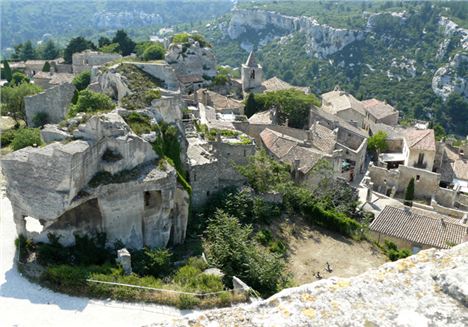 Precipitous Les Baux from one of the castle towers
Precipitous Les Baux from one of the castle towers
Next to Les Baux is a unique interesting attraction, that was called the Cathedrale d’Images but is now called Carrières de Lumières (Quarry of lights), where vast images are projected on quarry walls, with a new theme every year. The current show (March 7-January 4 2015) “takes you on a journey through 100 years of Viennese painting to the heart of the bright, colourful works of Gustav Klimt, his contemporaries and the artists he inspired.”
 Mas de la Dame's organic vineyard
Mas de la Dame's organic vineyard
The whole Alpilles area around Les Baux is foodie heaven. The Appellation Contrôlée area of Les Baux de Provence was created only 20 years ago and the climate encourages organic viticulture (I particularly recommend the range from Chateau Romanin, near St Remy-de-Provence). We bought olive oil and wine from the high profile Mas de la Dame, three miles from Les Baux. Van Gogh famously painted the farm and land, but the wines in his day were a far cry from today’s sophisticated, barrel-fermented Coin-Caché white and red.
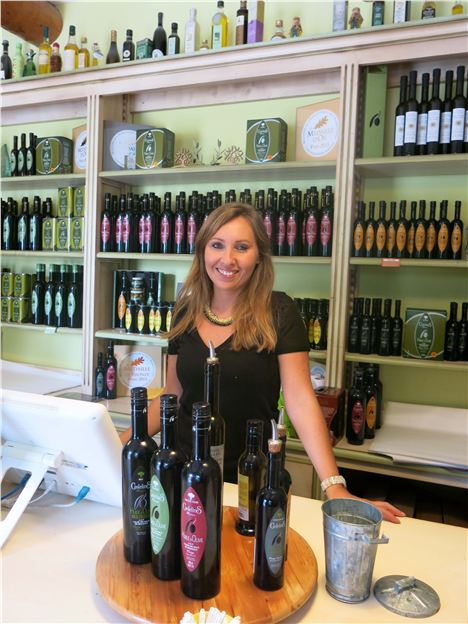 Castelas lass – olive oil tasting is a serious business around Les Baux
Castelas lass – olive oil tasting is a serious business around Les Baux
Not far away is the area’s best olive oil producer, according to Jean-Andre Charial. Castelas has its own chic sampling room, where we tasted our way through various single variety oils from the smooth and fruity to the decidedly peppery. Fascinating.
 In a farm shop in workaday (in an attractive Provencal way) Maussane-les Alpilles, south of Les Baux we also chanced upon a bottle of olive oil from the farm of one Charles Aznavour. This area does attract the rich and famous “returning to nature” in expensively renovated Mas or farmhouses. Our Mas B&B, en route to L’Oustau from Mausanne, was more rustic – Le Mas d’Esparou, run by the redoubtable Jacqueline Roux.
In a farm shop in workaday (in an attractive Provencal way) Maussane-les Alpilles, south of Les Baux we also chanced upon a bottle of olive oil from the farm of one Charles Aznavour. This area does attract the rich and famous “returning to nature” in expensively renovated Mas or farmhouses. Our Mas B&B, en route to L’Oustau from Mausanne, was more rustic – Le Mas d’Esparou, run by the redoubtable Jacqueline Roux.
Set on a rise among pines, it offers views for miles. By breakfast on the first morning, the keening Mistral wind had whipped up a raging thunderstorm across Les Alpilles. Over strong cafe noir and pastries, we watched open-mouthed as fork lightning set a distant hillside ablaze. Jacqueline rang the sapeurs pompiers (that wonderful French monicker for the Fire Service). After a long drought, this was dangerous stuff. The Valley of Hell, here we come.
 Duvel central, our retreat from the tourist hordes
Duvel central, our retreat from the tourist hordes
Fact file
L’Oustau de Baumaniere
The preferred rate: from 170 euros per room in a Classic Double.
Val d’Enfer, 13520 Les Baux de Provence. www.oustaudebaumaniere.com.
L’Oustau de Baumaniere is among 520 Relais & Châteaux properties, recognising the finest hotels and restaurateurs worldwide. For reservations call Relais & Châteaux: 00 800 2000 00 02 (toll free) or visit www.relaischateaux.com. Alternatively, visit the Maison des Relais & Châteaux at 10 Beauchamp Place, Knightsbridge, London SW3 1NQ, where the English-speaking Relais & Châteaux team will be delighted assist with your holiday plans.
The R&C concept grew from the vacationing traditions of well-heeled French society, who traveled to a variety of "relais" (lodges) and "châteaux" (castles) which, while different in architecture, scenery and cuisine, presented consistently high standards.
Budget alternative
Le Mas d’Esparou, off Route D5 south of Les Baux. Chambre d’Hotes.
www.lesparou-lesbaux.com.
Essential tourism information on Les Baux: www.chateau-baux-provence.com/en
Getting there
Fares from London to both Avignon and Antibes start at £119 standard class return per person. To book, contact Voyages-sncf (formerly Rail Europe) on 0844 848 5 848, visit www.Voyages-sncf.com or call into their Travel Centre at 193 Piccadilly, London W1J 9EU. They are the experts in train ticket distribution, covering over 30 countries across Europe.
To make the breakfast time Eurostar train to Paris rom St Pancras, Neil Sowerby stayed at London Central Euston Travelodge at 1-11 Grafton Place, a two minute walk from Euston Station and a further 10 minutes to St Pancras International Rail Terminal. The Euston, like Manchester Central, is among the Travelodges revamped to include Dreamer Beds and other fresh facilities. Double rooms at Euston start from £78.











